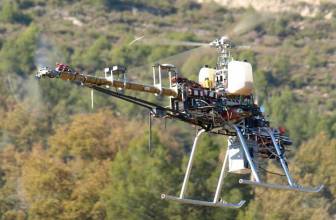 A Google self-driving car in Mountain View, California. Wikimedia Commons photo by grendelkhan.
A Google self-driving car in Mountain View, California. Wikimedia Commons photo by grendelkhan.Low-cost, precision, GNSS receivers will become a reality in the driverless cars, drones, and smartphone markets by 2021, said ABI Research in two new reports, “Precision GNSS in Automotive” and “GNSS IC Design Trends: Modules, Standalone, Combo, and Embedded.”
The automotive industry will be the main driver behind precision GNSS receiver adoption, in which centimeter-level accuracy is essential to complete driver safety systems with the redundancy necessary for autonomous vehicles, the company said.
Low-cost, precision, GNSS receivers will become a reality in the driverless cars, drones, and smartphone markets by 2021, said ABI Research in two new reports, “Precision GNSS in Automotive” and “GNSS IC Design Trends: Modules, Standalone, Combo, and Embedded.”
The automotive industry will be the main driver behind precision GNSS receiver adoption, in which centimeter-level accuracy is essential to complete driver safety systems with the redundancy necessary for autonomous vehicles, the company said.
While the automotive industry is investigating several competing technologies, ABI believes it will move into a hybridized approach, combining LiDAR, high definition maps, sensor fusion, machine vision, and precision GNSS.
“As the receivers’ average selling price drops below $50, we expect to see a more immediate market for location technology services, such as AR Heads Up Displays (HUDs), in high-end vehicles,” said Patrick Connolly, ABI Research principal analyst. “Vehicle-to-Vehicle, or V2V, communication might constitute another use case for high-precision GNSS.”
ABI Research believes, in addition to driverless cars, opportunities will arise for low-cost, precision GNSS receivers in autonomous unmanned vehicles (AUVs), as well as commercial and consumer devices. The company says that although the average selling prices of such GNSS receivers is $1,000 and higher, it finds the cost to be one of the most addressable inhibitors to market growth today.
“Precision GNSS achieves sub-meter accuracy through a variety of methods, including a network of reference stations,” Connolly said. “The biggest question mark today is not cost-related, but instead how to achieve reliable, worldwide satellite navigation coverage to support correction techniques, such as real time kinematic (RTK) and precise point positioning (PPP). This is an extremely expensive undertaking, with currently no guarantee of a return on investment.”
ABI says competition in the location technologies market ranges from crowdfunded startups to Internet giants, reflecting the scale of the opportunity. “Traditional precision GNSS receiver vendors like Trimble and Novatel have the intellectual property, engineering experience, and ownership of correction networks,” the company said.
In the consumer GNSS receiver market, u-Blox and Skytraq lead the way, the company said. “Each developed low-cost single frequency PPP and RTK receivers, with a clear roadmap toward dual-frequency. Other consumer GNSS providers, like ST Microelectronics, Broadcom, and Qualcomm, also appear active in this space,” ABI said.
Start-ups like North Surveying, NVS Technologies, REACH, and Swift Navigation continue to disrupt the industry, bringing low-cost precision receivers to market, the company said. “Their goal is to hit an ASP [average selling price] below $100 in the near future. And Radiosense is a startup that received a lot of attention for its previous work concerning precision GNSS on smartphones,” ABI said. “It is now working on automotive solutions in a pilot in Austin, Texas. Locata has the potential to be the wildcard in the deck, working on a powerful synchronization and location technology that may find its way into consumer technologies by 2021.”
Most interesting in the location technology competitive landscape is the involvement of Internet giants Google and Alibaba, Connolly said. “Google recently announced it will make GPS pseudoranges available to developers, which, although extremely nascent, could open up the door for a lot of innovation. And in China, Alibaba is a major partner in the roll-out of Continuous Operating Reference Stations, or CORS, networks in the region,” he said.





